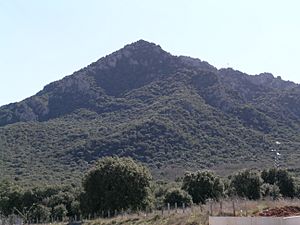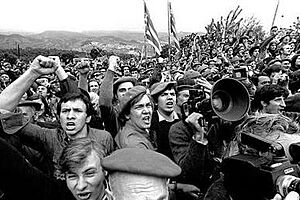Montejurra massacre facts for kids
Quick facts for kids Montejurra incidents |
|
|---|---|

View of Montejurra from the Monastery of Irache
|
|
| Location | Montejurra, Navarre |
| Date | May 9, 1976 |
| Target | Carlist Party members |
|
Attack type
|
Shooting |
| Weapons | Small arms |
| Deaths | 2 |
|
Non-fatal injuries
|
3 |
| Perpetrators | Far-right activists |
The Montejurra incidents were a violent attack that happened on May 9, 1976. During an annual gathering of the Carlist Party in Montejurra, Navarre, Spain, two Carlist members were killed. Three others were seriously hurt by gunmen from far-right groups.
Contents
What Happened at Montejurra?
The Carlists were a group that supported a certain type of monarchy in Spain. They had been part of the Nationalists who fought with Franco in the Spanish Civil War (1936-1939).
Over time, the Carlist movement split into two main groups. One group was more traditional and wanted an old-style monarchy. The other group was newer and had more modern, socialist ideas.
The Attack on the New Carlists
The newer, more modern Carlist group became the target of a violent attack. This attack was planned by people who still supported Franco and had power in the government.
Two supporters of the Carlist leader, Carlos-Hugo de Borbón-Parma, were killed. Their names were Ricardo García Pellejero and Aniano Jiménez Santo.
At the time, a British magazine called The Economist wondered if the government was involved. They pointed out that the area was heavily policed. Yet, many gunmen were able to set up an ambush and escape without being caught by officials.
Who Was Involved?
Some people believed that Stefano Delle Chiaie, a far-right Italian, was involved. Also, 15 former members of a group called the Argentine Anticommunist Alliance (Triple A) were thought to be there. One of them was Rodolfo Almirón. Later, he was found to be the head of security for Manuel Fraga, who was a government minister in Spain. This news caused a public outcry, and Fraga had to fire Almirón.
Another person present was Jean Pierre Cherid. He was a former member of a French group called OAS. He later joined other violent groups in Spain.
The Spanish intelligence agency, SECED, reportedly brought far-right members to the Montejurra event. Other extreme groups also contacted international far-right members.
Government Connections
Some people claimed that the attack was organized with help from Carlos-Hugo's younger brother, Sixto Enrique de Borbón. He disagreed with Carlos Hugo's new ideas for the Carlist movement.
It is widely believed that high-ranking police officials and the SECED intelligence agency supported this plan. The plan was secretly called Operación Reconquista. Some historians say that money for the plan came from Antonio María de Oriol de Urquijo, a leader of the traditional Carlists.
According to the memories of General Sáenz de Santa María, the plan was put together in the office of General Juan Campano. Campano was the head of the Guardia Civil, a police force. Sáenz de Santamaría said that Campano stated the Prime Minister, Arias Navarro, and the Interior Minister, Fraga, approved the operation.
Even though security forces were very close by, no one was arrested. No weapons were taken from the attackers. There was even photo evidence of one of the gunmen, but he was never brought to trial.
What Were the Consequences?
The Carlist Party pushed the government to act. As a result, two Spanish citizens, José Luis Marín García Verde and Hermenegildo García Llorente, were charged with murder. However, they were released without trial in March 1977. This was part of a general pardon for political prisoners.
In 2003, after many years, the Spanish high court finally ruled. They decided that the two Carlists who died were victims of terrorism. This decision allowed their families to receive money from the Spanish Government.
In 2007, a Spanish lawyer filed charges against Rodolfo Almirón. He was the leader of the Triple A. The lawyer wanted him tried for his actions during the Montejurra events. Almirón had been caught in Spain in 2006. He was wanted for murder charges in Argentina. He was sent back to Argentina, but he had a stroke and could not stand trial. He died in 2009.
See also
 In Spanish: Sucesos de Montejurra para niños
In Spanish: Sucesos de Montejurra para niños
- List of right-wing terrorist attacks
- Carlism
- Ezeiza massacre
- Operation Gladio


